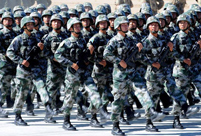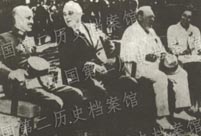 YOG kicks off in Nanjing
YOG kicks off in Nanjing
 Colorful life at Youth Olympic Village of Nanjing 2014 YOG
Colorful life at Youth Olympic Village of Nanjing 2014 YOG
 Royal Taoist temple to open to public
Royal Taoist temple to open to public
 Female soldiers at quake-hit area
Female soldiers at quake-hit area
 Shocking photos of cruel battles in Ukraine
Shocking photos of cruel battles in Ukraine
 Amphibious armored vehicle unit conducts open sea drill
Amphibious armored vehicle unit conducts open sea drill
 Water relay in Henan
Water relay in Henan
 Ethnic culture feasts eyes of travelers
Ethnic culture feasts eyes of travelers
 80 security dogs assembled in Nanjing police dog training base
80 security dogs assembled in Nanjing police dog training base
 Graffiti artists paint on street walls in Xinjiang
Graffiti artists paint on street walls in Xinjiang
BEIJING, Aug. 26 -- The State Archives Administration has published a video series on the War of Resistance Against Japanese Aggression to depict historical events and honor the Chinese fighting spirit.
The first part of the series on the July 7 Incident in 1937 was released on Monday by the administration's official website.
The July 7 Incident marked the beginning of China's eight-year War of Resistance Against Japanese Aggression when Lugou Bridge, known as Marco Polo Bridge to Western people and a crucial access point to Beijing, was attacked by Japanese troops.
The video clips depict the night of July 7, 1937, when Japanese troops carried out so-called military training maneuvers in the vicinity of Lugou Bridge, and demanded entry to the nearby town of Wanping to search for a missing soldier, which was refused by the Chinese side.
Later, Japanese soldiers besieged Wanping and launched an attack. The Chinese regimental commander Ji Xingwen led the Chinese defenses.
The incident led directly to Japan's full-scale invasion, with Beiping (former name of Beijing), Tianjin and other northern cities being occupied at the end of July 1937.
After the incident, the Communist Party of China called on the people to fight the Japanese, which was echoed by Chiang Kai-shek, the Kuomintang leader.
China will hold national memorial activities on Sept. 3 each year to mark "Victory Day," the day after the Japanese government officially surrendered on Sept. 2, 1945.
In February this year, the day was designated through legislative procedures as the Victory Day of the Chinese People's War of Resistance Against Japanese Aggression.
 Special holidays
Special holidays World's top 10 fighters
World's top 10 fighters 'Stewardesses' serve in hospital
'Stewardesses' serve in hospital Beautiful night scenery of Nanjing
Beautiful night scenery of Nanjing ‘Peace Mission -2014’ joint anti-terror military exercise kicks off in China
‘Peace Mission -2014’ joint anti-terror military exercise kicks off in China Eye-catching guides at the opening ceremony of YOG in Nanjing
Eye-catching guides at the opening ceremony of YOG in Nanjing A female missile launch company of PLA
A female missile launch company of PLA China, the U.S., Britain and the Soviet Union call for Japan's unconditional surrender
China, the U.S., Britain and the Soviet Union call for Japan's unconditional surrender Photo story: How a baby panda grows up
Photo story: How a baby panda grows up Star-leveled nursing home in a small county
Star-leveled nursing home in a small county Evidence of monstrous crime of Japanese invaders
Evidence of monstrous crime of Japanese invaders Foreign models compete with Chinese in Cheongsam show
Foreign models compete with Chinese in Cheongsam show The beautiful pictures of ancient Chinese architecture
The beautiful pictures of ancient Chinese architecture The Muslims involved in relief work
The Muslims involved in relief workDay|Week|Month